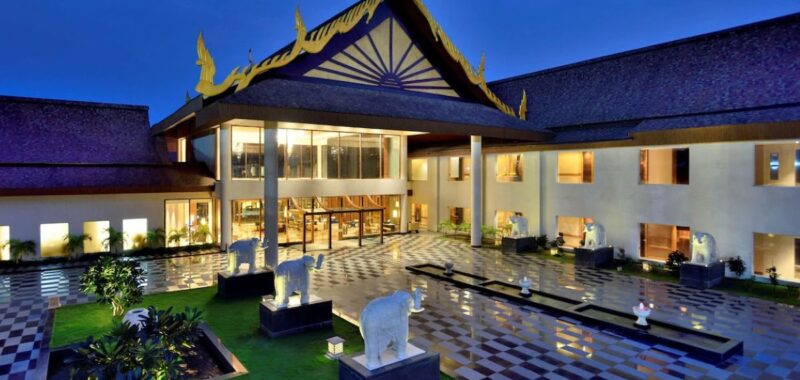In 2024, the hotel industry’s room rates stabilized in India, increasing 7-9% from 2023 after sharp rate hikes in 2022-23, noted hospitality consultant HVS Anarock in its latest report. The room rates and revenue per available room (RevPAR) increased even as the overall nationwide occupancy remained around 63-65%. This was marginally higher than 2023, but still not at pre-Covid occupancy rates.
“A year ago, the question was if the bull run that we were witnessing is likely to continue as we moved into the next financial year,” said Mandeep S. Lamba, president and CEO (South Asia) at HVS Anarock. There were fears of a slowdown due to the general elections in India and the global impact of U.S. elections. “Notwithstanding the concerns, the Indian hospitality sector continued its upward performance trajectory with a healthy double digit RevPAR growth,” he noted.
The consultancy firm noted that major trends such as spiritual travel, live events, weddings, and corporate travel impacted the travel and tourism industry in India. On live events, it said, “Annual spending on concerts and live entertainment was estimated at INR 16-20 billion ($190-236 million), with 25% directed toward hotels and transport—directly benefiting the tourism and hospitality sector.”
Major Surge in Signings: In 2024, a total of 484 branded hotels were signed, up from 328 properties in 2023. This accounted for over 47,000 branded keys being signed, an increase of 62% from the 29,000 rooms signed the year prior. “Another key trend in 2024, was the notable rise in the average room count per property, which rose to 98 rooms, up from 89 keys in 2023. This shift was largely driven by the signing of several large-scale projects,” the report added.
A key trend that HVS Anarock’s report highlights is the growing importance of Tier 3 and 4 cities, which accounted for 46% of room signings last year. By property, 54% of the signings were in these regions.
Last year, 200 properties also opened with 13,482 rooms, an increase of 8% year-on-year. “Domestic brands continued to dominate the expansion, accounting for 76% of the new openings by properties, further solidifying their stronghold over international hotel chains in the market,” the firm noted.
Airport Lounge Player Travel Food Services Gets IPO Nod
Airport restaurant and lounge business player Travel Food Services has received the regulator’s approval for its INR 20 billion ($236 million) IPO. The company had filed its IPO papers in December last year.
Travel Food Services has presence across 14 airports in India including Delhi, Mumbai, Bengaluru, Hyderabad, Chennai, and Kolkata. It is also present in three airports in Malaysia. The company’s portfolio features various food and beverage concepts for travelers such as cafes, bakeries, food courts, and bars and is primarily present at airports and some highway locations.
The proposed IPO is entirely an offer-for-sale (OFS) of shares by the company’s promoter Kapur Family Trust. This means that the company will not receive any funds from the issue and the proceeds will go entirely to the selling shareholder.
Kerala Has Most Luxury Hotels in India
The southern state of Kerala has the most number of luxury hotels in India, according to data released by the Union Ministry of Tourism. The state is also leading in terms of presence of four-star and three-star hotels.
Currently, 94 five-star hotels are present in the state, along with 420 four-star properties and 607 three-star hotels. At second spot is Maharashtra, which has 86 five-star, 36 four-star, and 69 three-star properties. The number of luxury hotels in Gujarat stands at 76, while it has 61 four-star and 120 three-star hotels.
Kerala is a tropical destination and is often preferred by tourists due to its natural beauty, culture, and strong marketing efforts. Last year, the state received a record 22.25 million tourists, up 21% from pre-Covid levels. Moreover, a key reason for the rise in star-rated hotels is the state’s regulation that requires a minimum three-star rating for hotels to obtain a bar license.
Goa Banks on Air Connectivity to Attract High-Value Tourists
Repositioning itself as more than just a beach destination, Goa is highlighting itself as a year-round destination globally. Speaking at the Arabian Travel Market, the state’s tourism minister Rohan Khaunte said, “Post-Covid, we have realized that Goa holds immense untapped potential. Tourists today want more than a single experience; they want diversity and Goa offers that.”
He added that the state has been able to increase the average length of stay by diversifying its offerings. “These post-pandemic learnings have led us to target new, high-value markets like the UAE, which is a strategic region for us,” he said.
The state also highlighted the expanding air connectivity. There is direct air connectivity between Goa and Dubai, and with two operational international airports, the coastal state is expecting to attract more travelers from the Gulf region.
India Among Preferred Destinations for Middle East Travelers
India is the third-preferred destination for travelers in the Middle East, according to online travel company Wego. In the first four months of 2025, Egypt and Saudi Arabia were the top two destinations, while India ranked third.
Apart from a strong expat population in the Middle East, India has also been witnessing an increase in air connectivity with the region. Budget carrier IndiGo has launched new flights to Abu Dhabi, while Akasa Air has been focusing on the region for its initial international expansion. Royal Jordanian also announced its plans to commence flights to Delhi and Mumbai.
Star Air Expands Fleet, Network
Indian regional airline Star Air on Tuesday inducted its 10th aircraft, an Embraer E175 jet. By March of next year, the airline is planning to add four more Embraer E175 Aircraft. It is also looking to operate a fleet of 25 by March 2027.
The airline is also expanding its network. It said that it will add 15 new sectors to its schedule, increasing its operations to over 50 daily services across 24 destinations.


